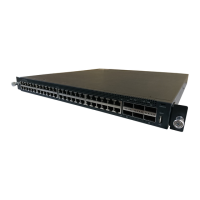User’s Guide FUJITSU PSWITCH
December/2018 143
The VRRP protocol enables two or more virtual routers running
on different physical switches to form a VRRP group. The Virtual
Routers running on the same physical switch cannot form a
VRRP group with each other.
The Border Gateway Protocol is intended to be used by
Customer Edge (CE) switch to communicate with other CE
switches and PE switches across the Provider Network. The BGP
runs in the default router context and is aware of the Virtual
Routers. BGP is used to:
1. Redistribute VPN routes from Virtual Routers on the CE
switch to the attached PR in Provider Network.
2. Leak routes dynamically between different Virtual Routers
on the same physical switch. This requires support for BGP
extended communities and route targets.
VRF-Lite supports only IPv4. IPv6 data forwarding and protocols
are not supported.
VRF supports only IPv4 unicast routing.
PBR is a routing policy feature useful in overriding routing
decisions with programmable rules. PBR is supported only in
the default router.
DHCP server is not VR-aware.
IP Helper relays the broadcast packets received on a Routing
interface in the VRF context to the configure server address. The
server is looked up in the RTO specific to that VR only. Relay
across VRs is not supported.
Table 3-8: VRF Lite
Layer-2 features are not affected by VRF-Lite.
3.2. Operation Samples
3.2.1. VLAN setting
3.2.1.1. untagging VLAN
This section explains how to set up untagged packets grouped by port on the port
VLAN.

